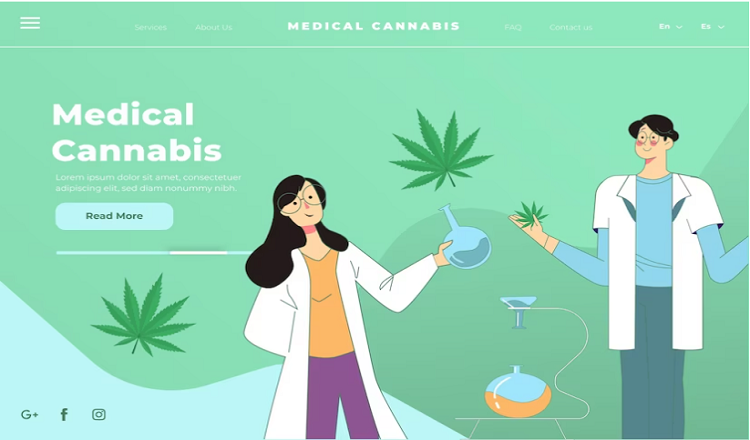
In recent years, the use of medical cannabis has become a heated topic in the United States as more and more states legalize it. However, what precisely is medical marijuana and how does it operate? The science underlying this contentious plant holds the key to the solution.
Understanding the science behind medical cannabis is crucial now more than ever as its acceptance grows. Medical marijuana not only has the ability to treat a variety of ailments, but it also has the power to completely alter the way we approach healthcare. We can’t fully take advantage of medical cannabis’ advantages though unless we have a clear understanding of how it functions.
In this article, we’ll examine the science behind medicinal cannabis and look at its different applications, methods of use, legal status, dangers and potential side effects, as well as its future prospects. You’ll have a firm understanding of the science underlying medical cannabis and its potential influence on American healthcare by the end of this article. So take a seat back, unwind, and prepare to explore the fascinating world of medical marijuana.
What is medicinal marijuana?
A plant-based medication called medical cannabis is used to treat a variety of ailments. It originates from the cannabis plant, which is home to more than 100 distinct cannabinoids. Tetrahydrocannabinol (THC) and cannabidiol (CBD) are the two most widely used cannabinoids.
The “high” associated with marijuana use is caused by THC, a psychoactive ingredient in cannabis. Contrarily, CBD has a variety of therapeutic uses and does not have the same intoxicating effects as THC. The body’s endocannabinoid system is a complicated network of receptors and neurotransmitters that controls a number of basic activities, including appetite, mood, and pain perception. When medicinal cannabis is eaten, the cannabinoids interact with this system. As a result of this interaction, medical cannabis is becoming a more widely used alternative therapy option for a variety of diseases.
Conditions that medicinal cannabis treats
Medical cannabis has been proven to be effective in treating a range of diseases, including chronic pain, anxiety, and chemotherapy-related nausea and vomiting. According to research, medical marijuana can be a useful therapy choice for ailments like Parkinson’s disease, multiple sclerosis, and epilepsy.
Studies have also demonstrated that medicinal marijuana can be a practical substitute for conventional therapies like opioids, which can have detrimental side effects and can promote addiction. Medical marijuana can relieve pain to a similar extent as these conventional medications while posing a lesser risk of addiction. Medical marijuana is becoming a more widely used alternative therapy option for a variety of diseases as more study on its effectiveness is undertaken.
Administration methods
Medical cannabis can be consumed in a variety of methods, including smoking, vaporizing, edibles, tinctures, and topicals. Each method has specific benefits and drawbacks of its own.
While smoking and vaping provide fast impacts, they can be bad for your lungs. Although they take longer to start working and might be challenging to dose correctly, edibles provide longer-lasting benefits. Although they can be more expensive, tinctures provide a discrete and accurate way to absorb medical cannabis. Topicals can be used to treat localized pain, but they might not work for problems that are more systemic.
The effectiveness and durability of effects of medical cannabis might be affected by the mode of ingestion. For instance, while edibles have longer-lasting effects, smoking and vaporizing usually has speedier effects. Patients can select the most suitable intake technique for their particular needs by being aware of the benefits and drawbacks of each approach.
The US medical cannabis regulatory environment
The legal environment for medical marijuana in the US is complicated and changing all the time. Although medical marijuana is permitted in more than 30 states, it is still prohibited under federal law, which results in a contradiction between state and federal legislation. Access to medical cannabis for patients and corporate operations in the sector may be made challenging by this conflict.
Research into medical marijuana’s possible advantages and hazards is further hampered by the drug’s federal legal status. Despite growing acceptance and legality of medical cannabis, there is currently little research available on its benefits because of governmental restrictions. Recent federal legislative initiatives, however, might eventually offer greater guidance and support for medical cannabis research.
Risks and possible adverse consequences
Medical marijuana provides a wide range of possible therapeutic advantages, but it can also have unfavourable side effects. Dry mouth, a faster heartbeat, vertigo, and poor coordination are some possible negative effects of using medical cannabis. Additionally, prolonged use of medical cannabis, especially when smoked, might cause cognitive decline and respiratory issues.
When using medicinal cannabis, patients should exercise caution. For example, they should start with a low dose and gradually increase it as needed. They should also refrain from using heavy machinery or driving when high. Patients should also talk to their doctor about any dangers and side effects that could arise, especially if they have a history of substance misuse or psychiatric conditions. Patients can reduce the dangers associated with using medical cannabis by following the necessary precautions.
The future of medical marijuana
Research on medical cannabis is currently looking at how it might be used to treat a variety of ailments, such as pain, anxiety, and epilepsy. Current research is also looking into the possible advantages of particular terpenes and cannabinoids contained in cannabis.
Medical marijuana may become more commonly accepted as a therapy choice in the future, especially when more study is done and governmental restrictions are removed. Medical marijuana may offer an alternative therapy option for ailments that are now challenging to treat with conventional drugs, which could have important ramifications for healthcare and medicine. To completely comprehend the potential advantages and hazards of medicinal cannabis, however, and to create safe and efficient treatment procedures, further research is required.
Conclusion
In conclusion, understanding the science behind medical cannabis is essential because it is a therapy choice that is getting more and more well-liked for a range of ailments. We’ve spoken about what medical marijuana is, the ailments it can cure, the various ways to take it, the legal environment, and any risks or negative consequences that could result from using it.
Medical marijuana may become a more significant therapy option in the future as more study is undertaken, with potential advantages for people who have not received relief from conventional drugs. Both patients and healthcare professionals should keep up with the most recent advancements in the industry and exercise caution when utilizing medical cannabis.
Research and teaching on medical cannabis must continue if its potential advantages are to be fully realized. Studies on the effectiveness and safety of medical cannabis are included, as are initiatives to remove the legislative and regulatory obstacles that now obstruct research and patient access. Working together to increase our knowledge of medical cannabis will help patients and change the healthcare industry.
Read More You May Like:








